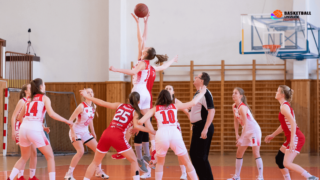
How Long Is a Quarter in Basketball High School?
Written by: Basketball Universe
Last updated:

For many of us, watching high school basketball games evokes a sense of pure nostalgia and excitement, while for others the question remains, “How long is a quarter in Basketball High School?” In this riveting blog post, we will uncover the striking differences between various playing lengths at diverse levels of the sport, and delve into the rules and regulations that govern the thrilling high school basketball games we all cherish. With a fun and professional approach, sit back, relax, and let us take you into the world of high school basketball and the time structure that keeps the game moving at a nail-biting pace!
How Long Is a Quarter in Basketball High School?
In high school basketball, a quarter typically lasts 8 minutes. However, this duration may vary slightly depending on the specific state or region’s regulations. The game consists of four quarters, with mandatory breaks in between to allow players to rest and strategize.
The Exciting World of High School Basketball Quarters
High school basketball is a captivating experience for players, coaches, and fans alike. While the general principles of the game remain consistent across all levels, high school basketball is unique in many ways. One key aspect of this distinctiveness is the length of each quarter. To ensure you can follow along and understand the game on a deeper level, we are here to provide a comprehensive guide to quarters in high school basketball.
A Standard Breakdown: 8-Minute Quarters
Typically, high school basketball games consist of four 8-minute quarters, adding up to a total of 32 minutes of gameplay. This timeframe is shorter than its counterparts in college and professional basketball, which feature 20-minute halves and 12-minute quarters, respectively. However, the high-paced nature of high school games keeps players and fans fully engaged, and the shorter length ensures that players maintain a balance between academics and athletics.
The In-Between: Halftime and Breaks
Besides the game time, high school basketball matches also include several breaks in between quarters. At the end of the first and third quarters, shorter breaks of around 2 minutes are taken, allowing players to catch their breath, recharge, and listen to their coaches’ instructions. A longer break, referred to as halftime, is observed between the second and third quarters. Halftime usually lasts 10-15 minutes and provides an opportunity for players to regroup and make more significant strategic adjustments.
Time Variations Across Regions
While 8-minute quarters are the standard length in the majority of high school basketball games across the United States, some state-specific adjustments to the duration do exist. For instance, some states have experimented with alternative quarter lengths, such as 6 or 7 minutes. However, these modifications are relatively uncommon and tend to be the exception rather than the rule. It is essential to be familiar with your local region’s regulations to stay informed and up-to-date with the most accurate information.
Federation vs. State Regulations
The duration of quarters in high school basketball is primarily determined by the National Federation of State High School Associations (NFHS), which governs interscholastic athletics and publishes the rules for high school basketball. Nevertheless, individual states reserve the right to make minor adjustments to these regulations, which can include changes to the length of quarters, breaks, and other procedural elements of the game.
Additional Clock Factors to Consider
Understanding the length of a quarter in high school basketball provides a foundational knowledge of the game; however, there are several other factors related to the game clock that must be taken into consideration for a more in-depth understanding. The following sections will elaborate on these clock elements to help you further your basketball know-how.
Shot Clock: A Key Differentiator
One of the most significant differences between high school basketball and its college and professional counterparts is the shot clock. While college and professional games mandate the use of a shot clock, high school games often do not feature one. In the absence of a shot clock, teams at the high school level can hold onto the ball for unlimited periods, often resulting in slower-paced games with lower final scores. However, some states have begun implementing shot clocks to enhance gameplay, mainly in response to stalling tactics that can dilute the excitement of the match.
Overtime: When Tied Games Demand More
If a high school basketball game ends in a tie after four quarters, it heads to overtime. Overtime periods typically last 4 minutes, providing teams with extra time to determine a clear victor. Consult your local state’s high school basketball regulations to determine if a different overtime duration is observed, as variations may exist. In the case of continued ties, additional overtime periods may be required until a winner is declared.
Timeouts: Planning and Strategizing
The importance of timeouts in high school basketball cannot be overstated, as they provide opportunities for coaches and players to strategize, plan, and assess their performance during the game. The number and length of timeouts allowed can differ by state, but the general rule allows each team to have five full-length timeouts, each lasting one minute. Teams may also have a few shorter, 30-second timeouts at their disposal. Timeouts during overtime periods are often determined by state-specific rules or the total remaining timeouts from regulation.
Why Should You Care About Basketball Quarter Lengths?
Understanding the structure of high school basketball quarter lengths provides a much-needed context for appreciating the game. Whether you are a player, coach, parent, or an ardent fan, equipping yourself with this knowledge will not only enhance your understanding of the sport but also your overall experience. Key benefits of such awareness include:
- Boosting your basketball IQ and appreciation for the game
- Opening up new avenues for strategic planning and coaching insight
- Ensuring that when engaged with other basketball enthusiasts, your conversations are enriched and informed
- Supporting student-athletes with empathy towards their dedication to balancing academics, athletics, and the inevitable time constraints associated with high school sports
Game On: Bringing It All Together
High school basketball is a captivating world, and the duration of its quarters plays a significant role in making it a thrilling experience for everyone involved. The 8-minute quarters, along with the breaks, strategy sessions, and pivotal clock elements, all contribute to creating an atmosphere of engagement and excitement. While being well-versed in these intricacies might not guarantee you a slam dunk on the court, it will definitely elevate your appreciation for the sport and enrich your conversations with other basketball enthusiasts. So embrace the knowledge, have fun, and enjoy the wonderful world of high school basketball!
Understanding High School Basketball Levels: Freshman, Junior Varsity, and Varsity
High school basketball often consists of three different levels, which include Freshman, Junior Varsity (JV), and Varsity. The length and structure of each quarter are generally consistent across these three levels, but there can be minor differences such as the number of allowed timeouts or players on the roster. Familiarizing yourself with these distinctions will help you better enjoy and participate in the game at any level.
Wheel of Fouls: Personal and Team Fouls Explained
Another crucial aspect of basketball at the high school level is fouls. Learning about personal and team fouls will enhance your understanding of the game and contribute to making better strategic decisions. A player can commit up to five personal fouls before “fouling out” and being disqualified from the contest. A team accumulates team fouls with each foul that their players commit; once they reach seven team fouls in a half, the opposing team enters the “bonus” and is awarded free throw opportunities. This system encourages players to focus on clean, skill-based play to avoid giving the opposing team an undue advantage.
Practice Makes Perfect: Preparing for the Game
It’s important for aspiring athletes to recognize that optimal performance in games is contingent upon the time and effort put into practice. As high school quarters are shorter and the game can become fast-paced, drills that cater specifically to short bursts of energy, skill development, and strategy comprehension will prove valuable for overall success on the court. Remember, the more tension and pressure you can handle in preparation, the more composed you will be during actual gameplay.
Fan Etiquette: Cheering and Building Team Spirit
Beyond the athletes themselves, the energy and enthusiasm of a basketball game are largely driven by the fans. As you become more knowledgeable about high school basketball quarter durations and other game-specific aspects, it is essential to understand and cultivate a culture of respect and etiquette within the crowd. Cheering for and encouraging players, demonstrating good sportsmanship, and fostering a positive environment are all important components of being a responsible and supportive fan.
Life Lessons: Beyond the Court
Finally, it is worth appreciating the invaluable lessons that high school basketball imparts to its participants. The time management complexity inherent in student-athletes’ lives, teamwork, resilience, and the discipline necessary to excel mirrors the challenges they will face in their future educational and professional endeavors. These life-long skills are worth celebrating and developing, both on and off the court.
Frequently Asked Questions
As with any sport, high school basketball has its intricacies, and those new to the game may have several questions. We’ve compiled a FAQ section addressing some of the most common questions related to the length of quarters in high school basketball and other relevant information. Explore the questions and answers below for further insight into this exciting realm.
1. How long is a quarter in high school basketball?
A quarter in high school basketball typically lasts 8 minutes, with four quarters making up a 32-minute game. However, this duration may vary slightly depending on the specific state or region’s regulations.
2. How long are the breaks in between quarters?
At the end of the first and third quarters, there are typically 2-minute breaks. In addition, there is a longer break of 10-15 minutes, known as halftime, between the second and third quarters.
3. What is the duration of an overtime period in high school basketball?
Overtime periods in high school basketball usually last 4 minutes. However, the length of an overtime period may vary slightly depending on the regulations of a specific state or region.
4. How many fouls are players allowed in a high school basketball game?
Players are allowed up to five personal fouls in a high school basketball game. Upon committing a sixth foul, the player “fouls out” and is disqualified from the contest.
5. How many timeouts are allowed in a high school basketball game?
Generally, each team is allowed five full-length (one minute) timeouts during a high school basketball game. Teams may also have a few shorter, 30-second timeouts. However, specific rules regarding timeouts may vary depending on the state.
6. Do high school basketball games use a shot clock?
Most high school basketball games do not use a shot clock. However, some states have implemented shot clocks to enhance gameplay and reduce the advantage of stalling tactics.
7. How many levels of high school basketball are there?
High school basketball is typically divided into three levels: Freshman, Junior Varsity (JV), and Varsity. The length of quarters remains generally consistent across these three levels, although there can be minor differences in other aspects of gameplay.
8. What is the ‘bonus’ in high school basketball?
The “bonus” refers to a situation in which a team’s opponents have accumulated seven or more team fouls in a half. In such a case, every subsequent foul results in free throw opportunities for the team not in the bonus.
9. Can high schools use different quarter lengths for their basketball games?
The length of quarters in high school basketball is primarily determined by the National Federation of State High School Associations (NFHS). However, individual states reserve the right to make minor adjustments, which can include changes to the length of quarters, breaks, and other procedural elements of the game.
10. Is there a mercy rule in high school basketball?
Some states and regions have implemented mercy rules, which come into effect when one team has a significant lead over the other. The specifics of a mercy rule may include a running clock or early game termination, depending on local regulations.
11. How long should practices be for high school basketball?
The length of high school basketball practices can vary depending on the team, coach, and available resources. Generally, practices last anywhere from 1.5 to 2.5 hours, with a focus on skill development, conditioning, and strategic planning.
12. What is a technical foul in high school basketball?
A technical foul in high school basketball is a non-contact foul, typically called for unsportsmanlike behavior, such as arguing with an official, using inappropriate language, or violating specific rules. Technical fouls result in the opposing team being awarded two free throws.
13. What is the 3-second rule in high school basketball?
The 3-second rule in high school basketball states that an offensive player cannot remain inside the designated lane area, also known as the key or the paint, for more than three consecutive seconds while their team is in control of the ball. If a player violates this rule, the opposing team is awarded possession of the ball.
Featured Posts
- No pillar pages found.





